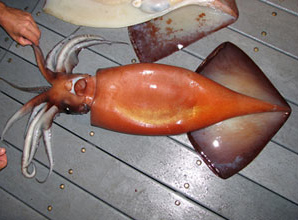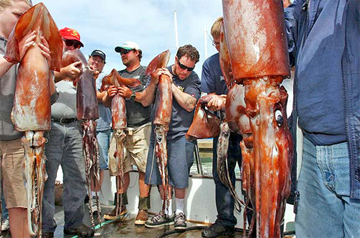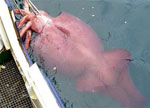Jumbo squid are back in the waters of Southern California and anglers are seeing an uptick in business, reports the Los Angeles Times.
The newspaper notes that more than 1,000 of the 4- to 5-long squid have been landed since Thursday night last week. The squid, also known as Humboldt squid, can reach a length of 8-feet (2.5 meters) and weigh up to 110 pounds (50 kg). They are voracious predators but are increasingly eaten by humans.
The Jumbo squid has made news in recent years as it increasing shows up off San Diego and Orange County beaches, expanding its range northward from the tropical Pacific from Peru to Baja California. The squid periodically “invades” Southern California, occasionally venturing as far north as Alaska.
 Kelly Benoit-Bird, Oregon State University |
No one is sure what causes Humboldt squid to show up in massive densities off the California coast, but depletion of sharks and swordfish — the species’ main predators — is believed to the factor allowing them to expand their range. Climate change and el Niñ may also play a role.
However research published in 2008 warned that jumbo squid may not enjoy conditions favorable for their expansion for long. Rui Rosa and Brad Seibel found that ocean acidification caused by changing oxygen and CO2 concentration will “substantially depress metabolic rates (31%) and activity levels (45%)” making it more difficult for the species to hunt in shallow waters — where conditions will be more acidic due to high CO2 levels — and avoid predation at depths exceeding 175 meters, due to reduced availability of oxygen.
“Squids will have to retreat to these shallower, less hospitable, waters at night to feed and repay any oxygen debt that accumulates during their [time at depth],” witre the authors. “The synergism between ocean acidification, global warming, and expanding hypoxia will compress the habitable depth range of the species. These interactions may ultimately define the long-term fate of this commercially and ecologically important predator.”
 Photo credit: Dana Rene Bowler (Ventura County Star) |
But in the meantime, squid are doing pretty well off the coast of Southern California. Of the thousand squid landed since Thursday, Eddie Kisfaludy, a marine biology collector at the Scripps Institution of Oceanography, told the Los Angeles Times, “That is a very, very small sample of the amount of squid that is out there now.”
Scientists—along with fishermen—are worried about the impacts on other fish populations.
“Having a new, voracious predator set up shop here in California may be yet another thing for fishermen to compete with,” Louis Zeidberg, a researcher who has studied the species, told the Associated Press in a 2007 interview about his study, which found that jumbo squid have already had an impact on marine food chain, triggering a drop in Pacific hake fish populations.
Related
 |
Giant squid use bioluminescence to hunt prey, communicate
(2/23/2007) The giant squid uses bioluminescence to hunt its prey, according to new deap-sea observations using a high definition underwater video camera system. The findings are published in the online edition of the Proceedings of the Royal Society B.
 |
Photos of world’s largest squid
(2/22/2007) Fishermen in New Zealand may have captured the largest Colossal squid ever recorded. It may be the first time a Colossal squid has ever been seen alive. The beast, weighing 450 kilograms (990 pounds), was eating a Patagonian toothfish (Chilean sea bass) hooked by fishermen when it was captured in the deep, frigid waters in the Ross Sea near Antarctica. The squid was reported to be 10 meters (33 feet) in length and took more than two hours to land.